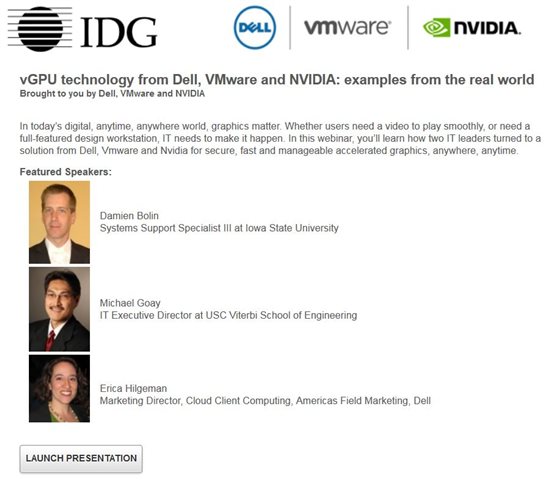While the University of Southern California (USC) is known for having produced visionary alumni such as Star Wars creator George Lucas and Star Trek creator Gene Roddenberry, more recently the university’s Viterbi School of Engineering has continued to embrace the future, adopting NVIDIA vGPU-enhanced virtual desktops and Wyse thin client endpoints. In addition to the many benefits of virtualizing graphical applications, the school is now saving money by streamlining IT asset management and enhancing data security by keeping intellectual property and critical research in its data center. The technology is also increasing user access by allowing Viterbi’s students to access assignments and data from nearly any location.
Indeed, at USC’s Viterbi School of Engineering, ranked 14th by U.S. News and World Report among the Best Global Universities for Computer Science, VMware Horizon with NVIDIA vGPU-enabled desktop virtualization is seen as an up-and-coming technology whose time has come. I recently spoke with Michael Goay, the program’s IT Executive Director, about the changes he has seen in their environment and how USC is addressing them. He mentioned something we have heard several times from Higher Education institutions as they discuss the shifts in their student population.
“Over the past few years we’ve noticed that incoming engineering students have a high level of competence in IT and higher expectations for the IT they use within the program,” Goay said. “They are increasingly mobile and have two or more personal devices including an IoT-connected device. We also noticed high enrollments in classes that require graphically-intensive software such as 3D CAD and 3D CGI animation.”
With approximately 6,300 students enrolled in various programs, the Viterbi School also fields roughly 1,700 non-engineering students enrolled in its classes. These enrollments are served by an IT team composed of 18 full-time employees plus 50 student workers supporting 27 computer classrooms, 900 desktops and laptops used for instruction and more than 200 software titles. Supporting those computer classrooms alone would be an onerous task. Until recently, in addition to supporting classroom and lab computers, the school’s IT department also distributed software for local installation on student-owned computers when permissible by academic software licensing. However, that practice introduced enormous support issues, further taxing limited resources.
Another challenge with local software installation on student-owned devices as a distribution paradigm, is that it is typically not possible to mandate a standard across devices. Many students’ devices don’t have the horsepower to run their required applications, especially those that render or necessitate higher-end graphics. This is a particular issue for students from lower income backgrounds. Like many educational institutions, USC wanted a solution to help level the playing field and bridge the so-called “digital divide.”
“That’s another thing that has really led us to consider virtual desktops with hardware accelerated graphics,” added Goay. “We are now able to support classes that require 3D rendering software using Wyse thin clients in our labs or by having the students’ access virtual desktops, where the graphical rendering takes place in the data center. With our new NVIDIA vGPU-enabled solution, even if they have a low-end PC or Mac, they can access and use graphically-intensive Windows-based applications.”
USC conducted a year-long pilot that leveraged VMware vSphere and Horizon View running on eight Intel powered Dell 12G PowerEdge R720 servers. Each server was configured with 384GB of RAM and included onboard NVIDIA GRID cards as well as Teradici APEX PCoIP offload cards. The initial goal was to boot non-persistent, VDI linked clones from local SSDs and then use Dell hybrid storage arrays to store student data.
In Phase 1, the program’s IT team right-sized the solution by conducting several pilots and making careful note of the students’ use cases. The goal was to balance the user experience with the resource allocation for VDI in a real-world environment. In Phase 2, scheduled for later this year, the engineering program plans to deploy additional Dell, VMware, and NVIDIA graphics-enabled virtual desktops and Wyse thin clients. This will further enhance security and act as a force-multiplier, boosting the capabilities of the current Dell solution.
“These new thin clients will cost much less than having full workstations in each classroom,” said Goay. “And with the VDI investment we’ve made, we can have virtual desktops with high-end graphics accessible inside and outside the classroom. We will be able to leverage that while also reducing our investment in traditional workstations for each classroom going forward. That’s a selling point that we have made to our administration as well.”
USC’s Viterbi School knows that the new program enabled by Dell, VMware, Intel and NVIDIA vGPU technology has been popular with students, based on scores gleaned from a periodic survey measuring engagement. “At the end of each semester, students fill out course evaluations and ‘learning environment’ is one of the data points that they evaluate,” said Goay. “The students have totally embraced the new technology and our faculty and the school’s administration have also totally embraced the technology. We know because they have spoken publicly about how much of a help the system has been to getting their work done.”
For more information, please contact Erica Hilgeman, Education Specialist in Dell’s Cloud Client-Computing Group, at erica_hilgeman@dell.com
To listen to the full presentation regarding NVIDIA vGPU technology from Dell, VMware, Intel and NVIDIA and how your organization can leverage secure, fast and manageable accelerated graphics, anywhere, anytime, please click below:

